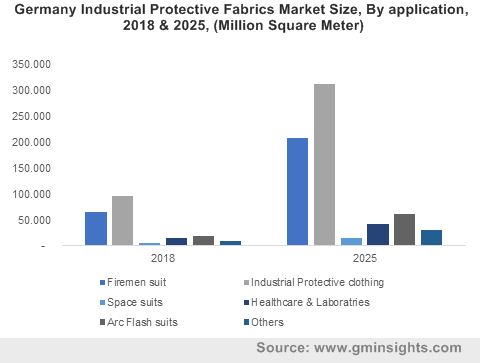Industrial safety fabrics market to register exponential growth from the O&G sector, aramid based protective fabrics to gain increased traction
Publisher : Fractovia | Published Date : 2019-06-04Request Sample
Increasing focus on employee safety and security in the manufacturing sector has led to an upsurge in the demand for Industrial safety fabrics market. The product is tailored for diverse applications including workwear, industrial safety, police, military, firefighters and more. In the industrial arena, it has offered workers with enhanced protection against hazardous elements and chemicals like oil, gas, liquid metal and more, and has further helped in avoiding fatal accidents as well as unnecessary production downtimes.
Germany Industrial Protective Fabrics Market Size, By application, 2018 & 2025, (Million Square Meter)

The material’s high strength, abrasion resistance, and low flammability have led to the product gaining increased traction across firefighting departments, which may depict a further upsurge, with rising number of fire outbreaks worldwide. For instance, according to the National Fire Protection Association (NFPA), in 2017, the U.S. fire department reported over 1.3 million fires, resulting in an estimated 3,400 deaths, around 15,000 civilian injuries, and about $23 billion worth of property loss. As protective fabrics are used to protect firefighters who have to walk in to such danger zones, it is rather overt that the Industrial protective fabrics market size from the flame resistant application may exceed USD 3 billion by 2025.
Expanding U.S. O&G sector and its impact on the industrial safety fabrics market
The U.S. Industrial safety fabrics market is estimated to register considerable profits owing to rising shale discoveries and soaring investments in the country’s petrochemical industry. In the oil & gas industry, workers face harsh environmental conditions and serious hazards like fire outbreaks, explosions, electric arc contact and more. To provide protection against such events, O&G companies have mandated use of protective fabrics during critical operations. Increase in investments in the oil & gas industry has also created lucrative job prospects in the U.S. employment sector. As the U.S. oil and gas industry workforce expands, it will in turn supplement the growth of the Industrial safety fabrics industry. Indeed, U.S. U.S. Industrial safety fabrics market share from flame retardant applications may depict a CAGR of 7.5% over 2019-2025.
In 2019, Exxon Mobil announced plans to invest $2 billion for expanding its Baytown chemical plant in Texas, generating 2,000 construction jobs and bolstering the region's petrochemical industry. Meanwhile, a 2018 study by the International Energy Agency claims that petrochemicals extracted particularly from oil & gas are gaining increased adoption in fertilizers, plastics, packaging and several other consumer products, and is estimated to account for over a third of the growth in world oil demand by 2030, and about half the growth by 2050. In spite of the efforts to move away from the use of fossil fuels, petroleum will continue to remain in high demand and will therefore indirectly augment growth scope of industrial protective fabrics industry.
Aramid-based Industrial safety fabrics market is anticipated to witness substantial gains on account of growing product adoption in defense and military applications. Thanks to its incredible resilience to heat and unmatched durability, aramid is increasingly being used in today’s military uniforms and accessories. The material, besides its extremely high flame resistance, offers tremendous mobility in the battlefield. Moreover, with additional treatments, aramid fabrics can offer efficient waterproofing capabilities all while being flexible to harsh environmental conditions.
Growing government regulation and investments in the defense sector will foster the aramid Industrial safety fabrics market growth as well. In February 2019, the Defence Industries Corporation of Nigeria (DICON), through the Ministry of Defence (MOD), had bagged an estimated $1.1 million (N4 billion) investment from Sur Corporate Wares to establish a military and paramilitary clothing & accessories factory in Kaduna state with plans to meet the accoutrement demands of the Nigerian Armed Forces and other uniformed paramilitary organizations. Such investments further underline the expansion of aramid-based industrial protective fabrics industry, that is anticipated to depict a CAGR of 8% over 2019-2025.
Impact of the healthcare & laboratories industry on the Industrial safety fabrics market
Advancements in the pharmaceutical industry along with rising awareness towards contagious diseases has led increased adoption of protective fabrics in the industry and has added a potent boost to the Industrial safety fabrics market. Medical protective clothing is an essential equipment used to protect doctors and professionals against pathogens, as well as patients against contamination. Personal Protective Equipment (PPE) also helps in preventing the spread of germs and secures patients and healthcare workers against potential infections.
In the past couple of years, the Industrial safety fabrics market has gained increased traction with the emergence of deadly diseases like Ebola and Influenza that require the use of protective suits to avoid exposure. In fact, in August 2018, the death toll from Ebola virus disease (EVD) outbreak in the Democratic Republic of the Congo was recorded to reach over 1,000, creating the need for protective suits during cremation or body disposal process. Advancements in vaccine production has also led to the use of protective fabrics, as researchers need to work in clean rooms to minimize contamination and maximize product quality and efficiency.
Driven by the needs of exponential number of professionals who have to put themselves in the way of harm to keep the wheels of economy rolling or to fight diseases to save the future of mankind, the Industrial safety fabrics market is slated to gain considerable impetus in the coming years. Reliable estimates cite that the global industrial protection fabrics market size will be pegged over USD 9 billion by 2025.